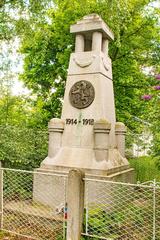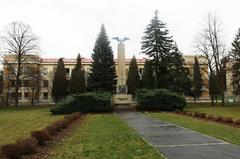
Crematorium Pardubice: Visiting Hours, Tickets, and Historical Information
Date: 04/07/2025
Introduction
The Crematorium Pardubice in Pardubice, Czech Republic, stands as a landmark of modern architecture and a testament to changing social attitudes toward death, remembrance, and community. Established in the early 20th century and designed by renowned architect Pavel Janák, it reflects the unique rondocubist style that is central to Czech heritage. Since its completion in 1923, it has served not only as a place of cremation but also as a site of historical, artistic, and social significance. This comprehensive guide covers the crematorium’s origins, architectural features, cultural legacy, practical visitor details, and its ongoing role in Pardubice’s cultural landscape. Whether you are an architecture enthusiast, a cultural tourist, or a local visitor, the Crematorium Pardubice offers a unique and meaningful experience (Wikimedia Commons, Accidentally Wes Anderson, Pardubice.eu).
Table of Contents
- Origins and Architectural Context
- Historical Development
- Social and Cultural Significance
- Preservation and Heritage Status
- Visiting Information
- Notable Events and Community Engagement
- Frequently Asked Questions (FAQ)
- Conclusion
- References
Origins and Architectural Context
While Pardubice is widely known for its medieval and Renaissance heritage, the Crematorium Pardubice marks a pivotal chapter in the city’s 20th-century development. The rise of cremation in Central Europe was driven by evolving perspectives on hygiene, public health, and urban planning. In the Czech lands, these changes culminated in the passage of the 1919 “Lex Kvapil” law, which legalized cremation (Accidentally Wes Anderson).
Pavel Janák’s design, selected from 81 entries in a national competition, embodies the rondocubist style, distinguished by its rounded forms and geometric motifs. The building’s architecture was inspired by both ancient Slavic mythology and early Christian basilicas, aiming to dignify the process of cremation and express the optimism and national identity of the newly formed Czechoslovak Republic (Pardubice.eu, Wikipedia).

Historical Development
Early 20th Century: The Rise of Cremation
With Pardubice’s rapid urban growth, especially following the arrival of the railway in 1845, the city became an important industrial and transportation hub (Wikipedia: Pardubice). Overcrowded cemeteries and public health concerns led to calls for modern, hygienic alternatives. The secularization of society also saw cremation embraced as a non-denominational practice.
Construction and Inauguration
Completed in 1923, the crematorium was the first of its kind in the Czech lands. Its layout includes a large ceremonial hall, technical crematory facilities, and landscaped grounds for contemplation. The restrained, monumental design gives the building a timeless and dignified presence, suitable for ceremonies of all faiths and backgrounds (Accidentally Wes Anderson).
Wartime and Postwar Periods
Throughout World War II and the communist era, the crematorium adapted to the changing political landscape. The state’s promotion of secularism further encouraged cremation, ensuring the facility’s continued relevance and integration into public life.
Social and Cultural Significance
Changing Attitudes
The establishment of the crematorium marked a progressive shift from traditional religious burial to inclusive, secular memorialization. It provided a dignified setting for families of all backgrounds, reflecting Pardubice’s diverse cultural fabric (Wikipedia: Pardubice).
Integration with Local Heritage
Though relatively modern, the crematorium complements Pardubice’s celebrated historic center, Renaissance square, Green Gate, and Pardubice Castle (WildTrips). Its presence underscores the city’s embrace of both tradition and innovation.
Memorialization and Community Role
The crematorium grounds host annual public commemorations and serve as a tranquil space for remembrance. Its two ceremonial halls—one large, one intimate—accommodate both community events and private services, fostering a sense of collective memory (Goodbye.cz).
Preservation and Heritage Status
The Crematorium Pardubice is officially listed among the Czech Republic’s national cultural monuments, ensuring its preservation and ongoing maintenance (Wikimedia Commons). Major restoration efforts were completed in 2009 to secure the building’s architectural integrity and improve accessibility. The crematorium is also well-documented in public archives and photographic sources.
Visiting Information
Location and Accessibility
Located in the Zelené Předměstí district, the crematorium is easily accessible via public transportation, car, taxi, bicycle, or on foot. Its proximity to other major sites makes it a convenient addition to any tour of Pardubice (WildTrips).
Hours and Tickets
- Opening Hours: Monday to Friday, 9:00 AM – 5:00 PM. Closed on weekends and public holidays. Always check the official tourism site for up-to-date information.
- Tickets: Entry to public areas is free. Guided tours and exhibitions typically cost around 100 CZK for adults, with discounts for seniors and students. Advance booking is recommended for tours or special events (Goodbye.cz).
Etiquette and Accessibility
As a place of mourning and reflection, visitors are asked to maintain respectful behavior. Photography is generally allowed in exterior spaces and designated areas, but restrictions may apply during ceremonies or inside the ceremonial halls. The facility is wheelchair accessible, with ramps and adapted restrooms. For specific needs, contact staff ahead of your visit.
Travel Tips
- Plan your visit alongside stops at Pardubice Castle and the Green Gate for a comprehensive cultural experience.
- Utilize public transport or city bike rentals for easy travel between sites.
Notable Events and Community Engagement
The crematorium frequently hosts memorial events, funerary art exhibitions, and participates in citywide cultural programs such as Museum Night (Pardubické Dnes). These events foster public engagement, education, and appreciation for the site’s historical and artistic value.
Frequently Asked Questions (FAQ)
What are the visiting hours of Crematorium Pardubice?
Monday to Friday, 9:00 AM to 5:00 PM. Closed weekends and public holidays. Always verify before your visit.
Is there an admission fee?
Public areas are free; guided tours/exhibitions cost around 100 CZK, with discounts for eligible groups.
Are guided tours available?
Yes, guided tours are regularly offered. Book in advance for guaranteed availability.
Is the site wheelchair accessible?
Yes, the crematorium is fully accessible for visitors with mobility challenges.
Can I take photographs?
Photography is permitted in most exterior and designated interior areas, but please refrain during ceremonies.
How do I get there?
Located in Zelené Předměstí, easily reached by public transport, car, or bicycle. Combine your visit with nearby attractions.
Conclusion
The Crematorium Pardubice is an outstanding example of Czech rondocubist architecture, a symbol of the city’s modernization, and a place for both private and collective remembrance. Its unique design, rich history, and active role in community life make it a must-visit for those interested in architecture, culture, or social history. To maximize your visit, explore guided tours, attend special events, and consider other nearby historical sites.
For the latest information, schedules, and updates, visit the official Pardubice tourism site, explore visual archives on Wikimedia Commons, and download the Audiala app for interactive tours and content.







